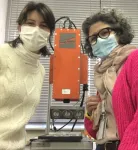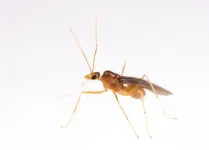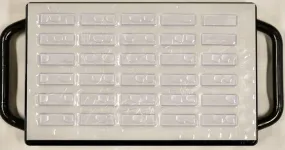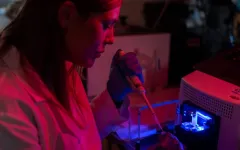(Press-News.org) Research Highlights:
A wireless or leadless (without wires) pacemaker was implanted in a select group of children with irregular heart rhythms during a 5-year period (2016-2021).
Smaller catheters that allow easier placement of the leadless pacemaker in children’s smaller bodies may expand wireless pacemakers as an option to consider for more children with irregular heart rhythms.
DALLAS, April 11, 2023 — Wireless or leadless pacemakers, commonly implanted in adults, may be a safe and effective short-term option for children with slow heartbeats, according to new research published today in Circulation: Arrhythmia and Electrophysiology, a peer-reviewed journal of the American Heart Association.
Children with a heartbeat that is too slow (bradycardia) require pacemakers — devices surgically implanted under the skin of the chest that transmit electrical impulses to regulate the heartbeat. Standard pacemakers use tiny wires, or leads, that are connected to the heart to deliver the lifesaving pacing (electrical signals to keep the heart beating normally). Active, growing children, however, are at higher risk for wire fractures and pacemaker complications because the wires in typical pacemakers may break or malfunction, according to researchers.
The leadless pacemaker is a miniature device, the size of a AAA battery, and it is self-contained and placed directly inside the patient’s heart. It does not require tiny wires (leads) to help regulate the heartbeat.
This study provides the first data on leadless pacemakers in a pediatric population in a real-world setting.
“The leadless pacemaker works very well in children, just like it does in adults. We found it may be safely implanted in select pediatric patients that need pacing,” said lead study author Maully J. Shah, M.B.B.S., director of cardiac electrophysiology in the Cardiac Center at Children’s Hospital of Philadelphia and a professor of pediatrics at the Perelman School of Medicine at the University of Pennsylvania, both in Philadelphia. “Our study’s results indicate select children may be considered candidates since they may benefit greatly from leadless pacing. However, because of the current technology, which uses a very large catheter designed for adults to place the leadless pacemaker and lack of reliable future extractability of the pacemaker, the wider pediatric population is not able to benefit from this device.”
The Pediatric and Congenital Electrophysiology Society (PACES) maintains a registry of pacemaker implantations performed at 15 centers across the U.S., U.K. and Italy. During the study period (2016-2021), cardiac electrophysiologists implanted the leadless device in carefully selected patients who were experiencing a slow heartbeat. Researchers evaluated data in the registry for one brand of leadless pacemakers to analyze how well the leadless pacemaker performed in 63 children, ages 4 to 21 years (average age 15). For 77% of these children, this was their first pacemaker.
The analysis found:
62 of the 63 children had the leadless pacemaker successfully implanted, and the heart’s electrical parameters were stable within the first 24 hours.
During an average follow-up period of about 10 months, the pacemaker was effective in its overall performance, including battery longevity, low pacing threshold (signals if pacemaker is performing well) and ability to detect the heart’s native electrical beats. Pacemaker batteries typically last 5-10 years, depending on how often the device is needed to maintain regular pacing, added Shah.
Overall, 16% (10) of the children experienced complications after receiving the leadless pacemaker. Most of these were due to minor bleeding, which was treated promptly and easily. There were 3 major complications — one blood clot in the femoral vein of one patient; one cardiac perforation; and one patient had sub optimal pacemaker function requiring removal of the pacemaker after one month.
“Using adult catheter-guided delivery systems in children is challenging and may increase the risk of major complications. Since these are big catheters, selection of patients by size is very important. Two out of the three complications occurred in patients weighing less than 60 pounds,” Shah said. “The femoral vein in the groin is the conventional route to place the leadless pacemaker. For some patients, especially the younger and smaller children, the jugular vein (in the neck) was a better option because it provides a more direct route to implant the tiny pacemaker in a smaller heart.”
During the follow-up period after implantation, the leadless pacemakers continued to have stable performance, and there were no reported complications. The researchers have now converted this retrospective study to a prospective study and plan to follow these patients for an additional 5 years.
“Leadless pacemaker technology is the wave of the future,” Shah said. “This is an excellent technology that may be offered to a wider pediatric population. However, techniques and tools to place the device must be designed for smaller patients, specifically children, and there needs to be a mechanism to remove and replace this pacemaker without surgery when the battery runs out since pediatric patients will likely require pacing for the rest of their lives, which is several decades after implantation.”
The major limitations of this study are the small study size and short term follow up.
“This initial report looking at implanting leadless pacemakers in children and adolescents may provide information to guide clinicians on how to select children who might benefit from a leadless pacemaker,” said Kenneth A. Ellenbogen, M.D., FAHA, co-author of the 2018 ACC/AHA/HRS Guideline on the Evaluation and Management of Patients With Bradycardia and Cardiac Conduction Delay, and Kimmerling Professor of Cardiology at the VCU School of Medicine in Richmond, Virginia. “This new information may also allow more access to leadless pacing for children.”
Co-authors are Alejandro A. Borquez, M.D.; Daniel Cortez, M.D.; Anthony McCanta, M.D.; Paolo De Filippo, M.D.; Robert Whitehill, M.D.; Jason Imundo, M.D.; Jeremy P. Moore, M.D.; Elizabeth Sherwin, M.D.; Taylor Howard, M.D.; Eric Rosenthal, M.D.; Naomi Kertesz, M.D.; Philip Chang, M.D.; Nandini Madan, M.D.; Steven Kutalek, M.D.; Benjamin Hammond, M.D.; Christopher M. Janson, M.D.; V. Ramesh Iyer, M.D.; and Matthew R. Williams, M.D. Authors’ disclosures are listed in the manuscript.
The study reported no funding. Dr. Shah is a consultant for Medtronic, the maker of the leadless pacemaker utilized in this study.
Studies published in the American Heart Association’s scientific journals are peer-reviewed. The statements and conclusions in each manuscript are solely those of the study authors and do not necessarily reflect the Association’s policy or position. The Association makes no representation or guarantee as to their accuracy or reliability. The Association receives funding primarily from individuals; foundations and corporations (including pharmaceutical, device manufacturers and other companies) also make donations and fund specific Association programs and events. The Association has strict policies to prevent these relationships from influencing the science content. Revenues from pharmaceutical and biotech companies, device manufacturers and health insurance providers and the Association’s overall financial information are available here.
Additional Resources:
Multimedia is available on the right column of release link https://newsroom.heart.org/news/wireless-pacemakers-may-be-safe-effective-for-children-with-irregular-heart-rhythms?preview=0d348d2af8af316db62011755d2ffe86
After April 11, view the manuscript online.
AHA/ACC and Heart Rhythm Society Guidelines: Societies Publish New Guidance for the Treatment of Slow, Irregular Heartbeats (Nov. 2018)
AHA media alert: Information and resources on heart rhythm issues and pacemakers (April 2021)
Follow AHA/ASA news on Twitter @HeartNews
Follow news from the AHA’s Circulation: Arrythmia and Electrophysiology journal @CirculationEP
About the American Heart Association
The American Heart Association is a relentless force for a world of longer, healthier lives. We are dedicated to ensuring equitable health in all communities. Through collaboration with numerous organizations, and powered by millions of volunteers, we fund innovative research, advocate for the public’s health and share lifesaving resources. The Dallas-based organization has been a leading source of health information for nearly a century. Connect with us on heart.org, Facebook, Twitter or by calling 1-800-AHA-USA1.
###
END
Wireless pacemakers may be safe, effective for children with irregular heart rhythms
Smaller catheters to place the leadless pacemaker may expand its use as an option for more children with slow heartbeats, according to a new study in the Circulation: Arrhythmia and Electrophysiology journal
2023-04-11
ELSE PRESS RELEASES FROM THIS DATE:
Protecting the cultural heritage of ancient bone artifacts is now possible. Near-infrared hyperspectral imaging and radiocarbon dating together to make the invisible visible
2023-04-11
An innovative method developed by an Italian team is emerging that will revolutionize the field of archaeology and radiocarbon dating and protect our cultural heritage. The researchers have used it with surprising results on archaeological bones, making the ‘invisible’ visible.
This important achievement-published in the journal Communications Chemistry of the Nature group-is the result of extensive research work coordinated by Professor Sahra Talamo, in which experts in the field of analytical chemistry from the University of Bologna and the University of Genoa collaborated.
The group has developed a new technique for analyzing archaeological ...
Worldwide, those with ‘traditional’ values adhered more strictly to COVID precautions
2023-04-11
Given the battles over COVID-19 rules and recommendations in the United States over the past three years, the findings of a new UCLA-led study may come as a bit of a shock: Globally, those who professed to hold traditional values tended to adhere more closely to coronavirus-prevention measures than those who considered themselves more liberal.
“Across a wide range of countries, people who endorsed traditional cultural values — a position that often underlies socially conservative political philosophies — ...
Male yellow crazy ants are real-life chimeras
2023-04-11
The yellow crazy ant, or Anoplolepis gracilipes, has the infamous distinction of being among the worst invasive species in the world. However, this is not the reason for which this particular ant is studied by a team of international researchers. What interests them is how the insects reproduce, because males of this ant have long perplexed scientists. "The results of previous genetic analyses of the yellow crazy ant have shown that the males of this species have two copies of each chromosome. This was highly unexpected, as males usually develop from unfertilized eggs in ants, bees, and wasps – and thus should only have one maternal copy of each chromosome," explained Dr. ...
Study shows patterns of opioid prescribing linked to suicide risk
2023-04-11
Controversy surrounds the effects of policies to reduce opioid prescriptions on suicide rates. There are concerns that rapid reductions in prescription opioids might provoke increased suicide risk among people who become desparate after they are taken off opioids. According to a new study at Columbia University Mailman School of Public Health and Columbia University Irving Medical Center, however, changes in regional opioid prescribing and regional suicide rates tend to move in the same direction. This relationship held for rates of opioid prescribing, rates of high-dose prescribing and long-term prescribing, and having multiple opioid prescribers. Until ...
Assessing the accuracy of artery models
2023-04-11
Testing the material used to build models of arteries reveals their suitability for use in medical education and surgical planning.
Hokkaido University researchers have analyzed the suitability of a smooth, flexible and transparent material used to make model arteries for use in medical teaching and to plan for surgery on individual patients. Their work is described in the Journal of Vascular and Interventional Radiology.
Ever-improving 3D printing technology can create models of blood vessels that are significantly more realistic than those made with more conventional methods, and also much more suitable for surgical ...
Combination therapy overcomes BET inhibitor resistance
2023-04-11
Scientists at St. Jude Children’s Research Hospital developed a novel combination therapy approach for a leukemia subtype harboring rearrangements in the KMT2A gene. The approach overcomes the cancer’s drug resistance, without adding toxicity. The study was published today in Proceedings of the National Academy of Science.
Bromodomain and extra-terminal domain (BET) inhibitors have been shown to provide therapeutic benefits against many different cancers. However, the mechanisms governing response and resistance to this class of therapies are poorly understood.
Scientists at St. Jude conducted CRISPR ...
Maryam Baldawi named winner of the 2023 AADOCR Gert Quigley Fellowship
2023-04-11
Alexandria, VA – The American Association for Dental, Oral, and Craniofacial Research (AADOCR) has announced Maryam Baldawi as the 2023 AADOCR Gert Quigley Government Affairs Fellow.
The Gert Quigley Fellowship is designed to familiarize graduate-level students with the federal legislative process in the context of dental, oral, and craniofacial research and the oral health care delivery system. As part of the Fellowship, Baldawi will complete a short work stay at AADOCR headquarters in Alexandria, VA. She will serve a one-year term as a voting member of AADOCR’s Government Affairs Committee and as the government affairs liaison to the AADOCR National Student ...
Parathyroidectomy shows no effect on kidney function in older adults with hyperparathyroidism
2023-04-11
1. Parathyroidectomy shows no effect on kidney function in older adults with hyperparathyroidism
Subanalysis suggests the procedure may preserve kidney function in younger patients if done early
Abstract: https://www.acpjournals.org/doi/10.7326/M22-2222
URL goes live when the embargo lifts
An emulated randomized trial performed using observational data from more than 43,000 adults with primary hyperparathyroidism found that parathyroidectomy had no estimated effect on long-term kidney function in older adults when compared to observation. However, ...
Parental knowledge and attitudes toward HIV preventive treatment for their adolescent children
2023-04-11
HIV pre-exposure prophylaxis (PrEP), a daily regimen of two medications in a single pill, could prevent many new HIV infections, especially in at-risk populations. For example, research shows PrEP could prevent around 70 percent of new HIV infections in adolescent cisgender sexual minority males (ASMM) and transgender and gender diverse adolescents (TGDA), populations that are disproportionately affected by the disease. However, despite growing awareness of PrEP among ASMM/TGDA, uptake of the treatment is still less than 5 percent.
A new study published in the journal Sexuality Research and Social Policy looks ...
Texas A&M researchers discover new circuit element
2023-04-11
Dr. H. Rusty Harris, associate professor in the Department of Electrical and Computer Engineering at Texas A&M University, has identified a new circuit element known as a meminductor.
A circuit element is an electrical component used to help direct and control the flow of electricity through an electrical circuit. The classical three are known as the resistor, capacitor and inductor. Two additional circuit elements, the memristor and the memcapacitor, were only discovered in the past 15 years. These newer circuit elements are known as the mem- versions of their classical counterparts, and their current and voltage properties are dependent ...
LAST 30 PRESS RELEASES:
Sleeping in on weekends may help boost teens’ mental health
Study: Teens use cellphones for an hour a day at school
After more than two years of war, Palestinian children are hungry, denied education and “like the living dead”
The untold story of life with Prader-Willi syndrome - according to the siblings who live it
How the parasite that ‘gave up sex’ found more hosts – and why its victory won’t last
When is it time to jump? The boiling frog problem of AI use in physics education
Twitter data reveals partisan divide in understanding why pollen season's getting worse
AI is quick but risky for updating old software
Revolutionizing biosecurity: new multi-omics framework to transform invasive species management
From ancient herb to modern medicine: new review unveils the multi-targeted healing potential of Borago officinalis
Building a global scientific community: Biological Diversity Journal announces dual recruitment of Editorial Board and Youth Editorial Board members
Microbes that break down antibiotics help protect ecosystems under drug pollution
Smart biochar that remembers pollutants offers a new way to clean water and recycle biomass
Rice genes matter more than domestication in shaping plant microbiomes
Ticking time bomb: Some farmers report as many as 70 tick encounters over a 6-month period
Turning garden and crop waste into plastics
Scientists discover ‘platypus galaxies’ in the early universe
Seeing thyroid cancer in a new light: when AI meets label-free imaging in the operating room
Neutrophil-to-lymphocyte ratio may aid risk stratification in depressive disorder
2026 Seismological Society of America Annual Meeting
AI-powered ECG analysis offers promising path for early detection of chronic obstructive pulmonary disease, says Mount Sinai researchers
GIMM uncovers flaws in lab-grown heart cells and paves the way for improved treatments
Cracking the evolutionary code of sleep
Medications could help the aging brain cope with surgery, memory impairment
Back pain linked to worse sleep years later in men over 65, according to study
CDC urges ‘shared decision-making’ on some childhood vaccines; many unclear about what that means
New research finds that an ‘equal treatment’ approach to economic opportunity advertising can backfire
Researchers create shape-shifting, self-navigating microparticles
Science army mobilizes to map US soil microbiome
Researchers develop new tools to turn grain crops into biosensors
[Press-News.org] Wireless pacemakers may be safe, effective for children with irregular heart rhythmsSmaller catheters to place the leadless pacemaker may expand its use as an option for more children with slow heartbeats, according to a new study in the Circulation: Arrhythmia and Electrophysiology journal



